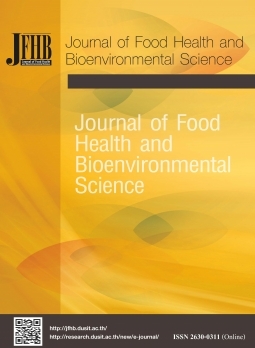Development of Horse Mango (Mangifera foetida) Jam and Consumer Acceptance
Keywords:
Horse Mango Jam, Jam properties, Consumer of jam acceptanceAbstract
The purposes of this research were to develop horse mango (Mangifera foetida Lour.) jam, to investigate the quality of the developed jam and consumer acceptance of horse mango jam. The methodology of research was conducted by studying three concentration levels (35%,45% and 55%) of ripe horse mango flesh suitable to be processed into horse mango jam and evaluating the jam properties: physical, chemical and microbiological quality and consumer acceptance of the jam. The experimental results indicated that ripe horse mango flesh could be suitably processed as jam, and that horse mango also had a unique smell. Furthermore, the quality of horse mango jam was investigated by measuring the quality of jam according to the Thai Community Product Standard (TCPS) criteria for coloring (L*a* b*) and spreadability used to deform the jam, it was found that 3 horse mango jams are concentrated in terms of color, odor and flavor, according to TCPS criteria: L*, a* decreased and b* increased when the concentration of horse mango jam increased. The texture of the jam decreased when the concentration of horse mango increased. Horse mango jam selection by sensory evaluation from 50 panelists found that horse mango jam 55% received the most favorable rating in terms of color, odor, flavor and overall liking and there was a significant difference with 35%, 45% jam (p <0.05). When using 55% horse mango jam for chemical and microbiological quality, it was found that jam contains the amount of β-carotene at 1.04 g, moisture at 28.5 g, ash 0.56 g protein 0.45 g, carbohydrate and fat 0.73 g per 100 grams of horse mango jam. The amount of microbes detected was not up to the standard of TCPS. For the acceptance of 100 consumers, consumers accepted 97% of jam and decided to buy horse mango jam at 76%.
References
AOAC. (2000). Official Methods of Analysis (17th ed.). Washington D.C.: Association of Official Chemists. Rockville, Maryland.
AOAC. (2016). Official Methods of Analysis (20th ed.). Washington D.C.: Association of Official Chemists. Rockville, Maryland.
Bekele, M., Satheesh, N., & Jemal, S. (2020). Screening of Ethiopian mango cultivars for suitability for preparing jam and determination of pectin, sugar, and acid effects on physico-chemical and sensory properties of mango jam. Scientific African, 7, 1-10.
Britton, G., Liaaen-Jensen, S., & Pfander, H. (2004). Carotenoids Handbook (Vol.1B). Basle, Switzerland: Birkhauser Verlag. Codex Standard 79. (1981). Codex Standard for Jams (Fruit Preserves) and Jellies. Rome, Italy: Codex Alimentarius Commission.
Ikram, E., & Khairul, H. (2009). Antioxidant capacity and total phenolic content of Malaysian underutilized fruits. Journal of Food Composition and Analysis, 22(5), 388-393.
Kostermans, G.H., & Bompard, J.M. (1993). The Mangoes: Their botany, normenclature, horticulture and utilization. London: Academic Press.
Lawless, H.T., & Heymann, H. (2010). Sensory Evaluation of Food. Ithaca, New York: Springer Science+Business Media, LLC. Lim, T.K. (2012). Mangifera foetida. In Edible Medicinal and Non-Medicinal Plants (pp. 82-86). Dordrecht, The Netherlands: Springer.
Ma, Y.Q., Ye, X.Q., Fang, Z.X., Chen, J.C., Xu, G.H., & Liu, D.H. (2008). Phenolic compounds and antioxidant activity of extracts from ultrasonic treatment of Satsuma mandarin (Citrus unshiu Marc.) peels. Journal of Agricultural and Food Chemistry, 56(14), 5682-5690.
Maturin, L.J., & Peeler, J.T. (2001). Chapter 3. Aerobic Plate Count. In Food and Drug Administration (FDA), Bacteriological Analytical Manual Online (8th ed.). Retrieved March 3, 2019, from https://www.fda.gov/food/laboratory-methods-food/bam-chapter-3-aerobicplate-count
Sompongse, W., Teerasilveesakul, P., & Srisaleekulrat, K. (2016). Extraction of tamarind seed (Tamarinuds indica L.) gum by microwave and its application in strawberry jam. Thai Journal of Science and Technology 24(2), 288-298.
Tyug, T.S., Johar, M.H., & Ismail, A. (2010). Antioxidant properties of fresh, powder, and fiber products of mango (Mangifera foetida) fruit. International Journal of Food Properties. 13(4), 681-691.
Wong, K.C., & Ong, C.H. (1993). Volatile components of the fruits of bachang (Mangifera foetida Lour.) and kuini (Mangifera odorata Griff.). Flavor and Fragrance Journal, 8, 147-151.
Downloads
Published
How to Cite
Issue
Section
License

This work is licensed under a Creative Commons Attribution-NonCommercial-NoDerivatives 4.0 International License.








